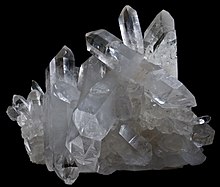
Back Kwarts AF Cuarz AN क्वार्टज़ ANP مرو (معدن) Arabic Cuarzu AST Kvars AZ Кварц BE Кварц BE-X-OLD Кварц Bulgarian क्वार्ट्ज BH
| Quartz | |
|---|---|
 Quartz crystal cluster from Brazil | |
| General | |
| Category | Silicate mineral[1] |
| Formula (repeating unit) | SiO2 |
| IMA symbol | Qz[2] |
| Strunz classification | 4.DA.05 (oxides) |
| Dana classification | 75.01.03.01 (tectosilicates) |
| Crystal system | α-quartz: trigonal β-quartz: hexagonal |
| Crystal class | α-quartz: trapezohedral (class 3 2) β-quartz: trapezohedral (class 6 2 2)[3] |
| Space group | α-quartz: P3221 (no. 154)[4] β-quartz: P6222 (no. 180) or P6422 (no. 181)[5] |
| Unit cell | a = 4.9133 Å, c = 5.4053 Å; Z = 3 |
| Identification | |
| Formula mass | 60.083 g·mol−1 |
| Color | Colorless, pink, orange, white, green, yellow, blue, purple, dark brown, or black |
| Crystal habit | 6-sided prism ending in 6-sided pyramid (typical), drusy, fine-grained to microcrystalline, massive |
| Twinning | Common Dauphine law, Brazil law, and Japan law |
| Cleavage | {0110} Indistinct |
| Fracture | Conchoidal |
| Tenacity | Brittle |
| Mohs scale hardness | 7 – lower in impure varieties (defining mineral) |
| Luster | Vitreous – waxy to dull when massive |
| Streak | White |
| Diaphaneity | Transparent to nearly opaque |
| Specific gravity | 2.65; variable 2.59–2.63 in impure varieties |
| Optical properties | Uniaxial (+) |
| Refractive index | nω = 1.543–1.545 nε = 1.552–1.554 |
| Birefringence | +0.009 (B-G interval) |
| Pleochroism | None |
| Melting point | 1670 °C (β tridymite); 1713 °C (β cristobalite)[3] |
| Solubility | Insoluble at STP; 1 ppmmass at 400 °C and 500 lb/in2 to 2600 ppmmass at 500 °C and 1500 lb/in2[3] |
| Other characteristics | Lattice: hexagonal, piezoelectric, may be triboluminescent, chiral (hence optically active if not racemic) |
| References | [6][7][8][9] |
Quartz is a hard, crystalline mineral composed of silica (silicon dioxide). The atoms are linked in a continuous framework of SiO4 silicon–oxygen tetrahedra, with each oxygen being shared between two tetrahedra, giving an overall chemical formula of SiO2. Quartz is, therefore, classified structurally as a framework silicate mineral and compositionally as an oxide mineral. Quartz is the second most abundant mineral in Earth's continental crust, behind feldspar.[10]
Quartz exists in two forms, the normal α-quartz and the high-temperature β-quartz, both of which are chiral. The transformation from α-quartz to β-quartz takes place abruptly at 573 °C (846 K; 1,063 °F). Since the transformation is accompanied by a significant change in volume, it can easily induce microfracturing of ceramics or rocks passing through this temperature threshold.
There are many different varieties of quartz, several of which are classified as gemstones. Since antiquity, varieties of quartz have been the most commonly used minerals in the making of jewelry and hardstone carvings, especially in Europe and Asia.
Quartz is the mineral defining the value of 7 on the Mohs scale of hardness, a qualitative scratch method for determining the hardness of a material to abrasion.
- ^ "Quartz". A Dictionary of Geology and Earth Sciences. Oxford University Press. 19 September 2013. ISBN 978-0-19-965306-5.
- ^ Warr, L.N. (2021). "IMA–CNMNC approved mineral symbols". Mineralogical Magazine. 85 (3): 291–320. Bibcode:2021MinM...85..291W. doi:10.1180/mgm.2021.43. S2CID 235729616.
- ^ a b c Deer, W. A.; Howie, R.A.; Zussman, J. (1966). An introduction to the rock-forming minerals. New York: Wiley. pp. 340–355. ISBN 0-582-44210-9.
- ^ Antao, S. M.; Hassan, I.; Wang, J.; Lee, P. L.; Toby, B. H. (1 December 2008). "State-Of-The-Art High-Resolution Powder X-Ray Diffraction (HRPXRD) Illustrated with Rietveld Structure Refinement of Quartz, Sodalite, Tremolite, and Meionite". The Canadian Mineralogist. 46 (6): 1501–1509. doi:10.3749/canmin.46.5.1501.
- ^ Kihara, K. (1990). "An X-ray study of the temperature dependence of the quartz structure". European Journal of Mineralogy. 2 (1): 63–77. Bibcode:1990EJMin...2...63K. doi:10.1127/ejm/2/1/0063. hdl:2027.42/146327.
- ^ Quartz Archived 14 December 2005 at the Wayback Machine. Mindat.org. Retrieved 2013-03-07.
- ^ Anthony, John W.; Bideaux, Richard A.; Bladh, Kenneth W.; Nichols, Monte C., eds. (29 January 1990). "Quartz" (PDF). Handbook of Mineralogy. Vol. III (Halides, Hydroxides, Oxides). Chantilly, VA: Mineralogical Society of America. ISBN 0962209724. Archived (PDF) from the original on 1 April 2010. Retrieved 21 October 2009.
- ^ Quartz Archived 12 November 2006 at the Wayback Machine. Webmineral.com. Retrieved 2013-03-07.
- ^ Hurlbut, Cornelius S.; Klein, Cornelis (1985). Manual of Mineralogy (20 ed.). Wiley. ISBN 0-471-80580-7.
- ^ Anderson, Robert S.; Anderson, Suzanne P. (2010). Geomorphology: The Mechanics and Chemistry of Landscapes. Cambridge University Press. p. 187. ISBN 978-1-139-78870-0.